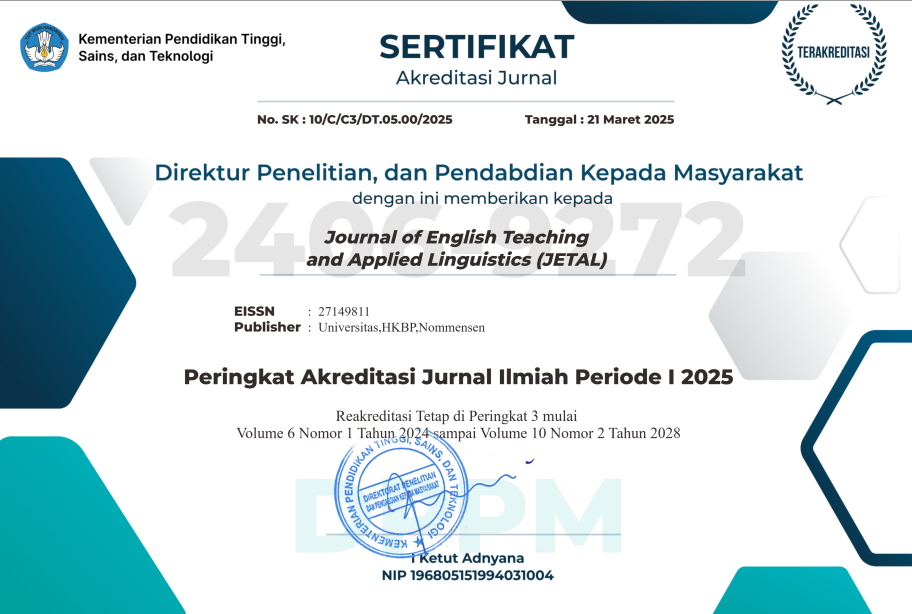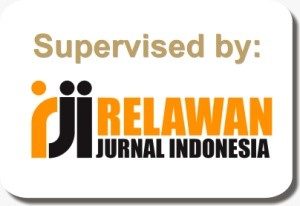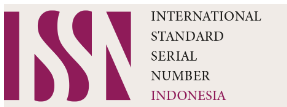An Analysis of Phonological, Morphological and Syntactical Errors on Teachers’ Talk in EFL Classroom
Abstract
This study investigated the teachers’ talk errors from phonological, morphological and syntactical aspects committed by EFL teachers during classroom instruction. It employed descriptive qualitative research. Through recording and transcription of teachers’ classroom meetings, the researcher found that the errors of teachers' talk occurred 96 times and the phonological errors dominated the teachers’ talk errors. It reached 55.2 % or occurred 53 times. The phonological errors covered the mispronouncing of pure vowels, diphthongs, triphthongs and some consonants. Furthermore, the second type of error was syntactical errors. They were committed 34 times or reached 35.4%. the errors comprised the incorrect word order and sentence structure or the misuse of tense. Meanwhile, the morphological errors were done 9 times or only reached 9.4 %. The errors included the misuse of verb, noun and pronoun.
The result of the study revealed that the EFL teachers who are supposed to be role models in using proper English, frequently make errors during classroom interaction. so that the result of the study is significant and expected to be able to raise the awareness of the EFL teachers about the importance of teacher talk in classroom interaction.
References
Dong-lin, Zheng. 2008. Teacher Talk in College English classroom. Online (http://www.linguist.org.cn/doc/uc20081108.pdf. Accesed on 23 dec 2021.
Ellis, R. (1994). The Second Language Acquisition. Oxford: Oxford University Press
Lekova, B. 2010. Language Interference and Methods of Its Overcoming in Foreign Language Teaching. Trakia Journal of Science. Stara Zagora, Bulgaria. Trakia University.
Mattarima, K., & Hamdan, A. R. (2011). The teaching constraints of English as a foreign language in Indonesia: The context of school based curriculum. Sosiohumanika, 4(2).
Mulyati, F. A. (2013). A Study Of Teacher Talk and Student Talk In Verbal Classroom Interaction To Develop Speaking Skill For Young Learners. Journal of English and Education 2013, 1-10.
Nunan, D. 1995. Language Teaching Methodology. Sydney: Phoenix ELT
Richards, Jack C. et al. 1992. Dictionary of Language Teaching & Applied Linguistsics. England: Longman Group UK Limited.
Schumann, John, H. 1978. The pidginization process: A model for second language acquisition. Rowley, MA: Newbury House.
Setiawati, L. (2012). A Descriptive Study On The Teacher Talk At EYL Classroom. Indonesian Journal of Applied Linguistics: Bandung, 1.
Sharpe, T. 2008. How Can Teacher Talk Support Learning? Linguistics and Education Journal. 9(2) pp 132-148. https://doi.org/10.1016/j.linged.2008.05.001
Xiao Yan. (2006). Teacher Talk and EFL in University Classroom. School of Foreign Languages and Literature ChongqingNormal University & Yangtze Normal University, China.
Zaim, M. (2002). Kesalahan Sintaksis dan Semantis dalam Terjemahan PembelajaranBahasa Inggris. Padang. Universitas Negeri Padang Press.
Authors retain copyright and grant the journal right of first publication with the work simultaneously licensed under a Creative Commons Attribution-ShareAlike 4.0 International License (CC BY-SA 4.0) that allows others to share the work with an acknowledgment of the work's authorship and initial publication in this journal.
Authors are able to enter into separate, additional contractual arrangements for the non-exclusive distribution of the journal's published version of the work (e.g., post it to an institutional repository or publish it in a book), with an acknowledgment of its initial publication in this journal.
Authors are permitted and encouraged to post their work online (e.g., in institutional repositories or on their website) prior to and during the submission process, as it can lead to productive exchanges, as well as earlier and greater citation of published work (See The Effect of Open Access).






